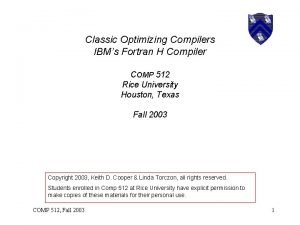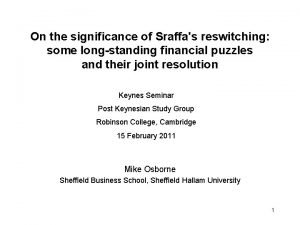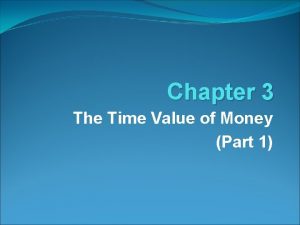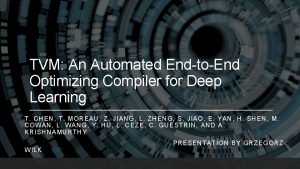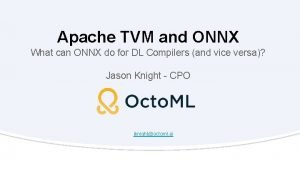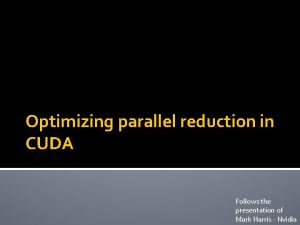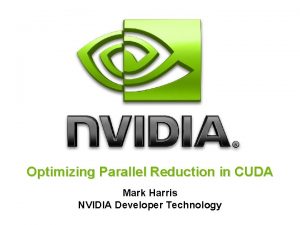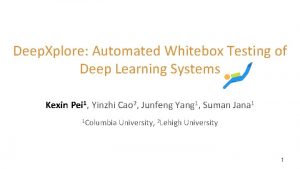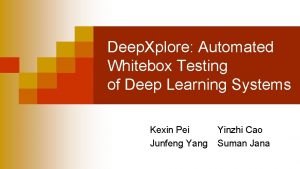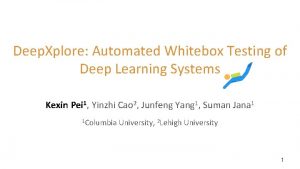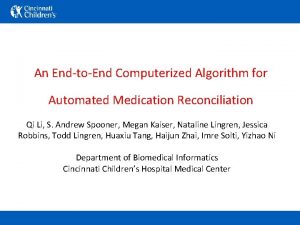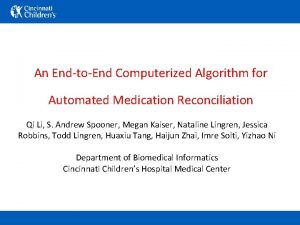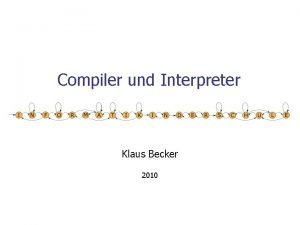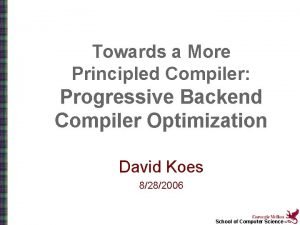TVM An Automated EndtoEnd Optimizing Compiler for Deep
















- Slides: 16

TVM: An Automated End-to-End Optimizing Compiler for Deep Learning T. CHEN, T. M OREAU, Z. JIANG, L. ZHEN G, S. JIAO, E. YAN , H. SHEN, M. COWAN, L. WANG, Y. HU, L. CEZE, C. GUESTRIN, AND A. KRISH NAMURTHY WILK PRESENTATION BY GR ZEGORZ

Background Goal: Rewrite the computational graphs to functionally equivalent, but more efficient ones. Subject to what hardware backend we are running on. High level computation graph optimizations as well as operator level optimizations.

TVM Computational Graph Optimizations ◦ Fuses whichever operators it can to reduce memory operations ◦ Transforms the shapes of intermediate tensor data to allow for more efficient execution on the used hardware

But what about lowlevel? ML computational graphs are often too high level to allow for hardware backend specific operator-level optimizations. Tensor-Flow, Py. Torch, MXNet all leave it to vendor libraries.

Separation of computation definition and low-level scheduling Halide’s approach extended with new optimizations.

Operatorlevel optimizations ◦ ◦ ◦ loop transformations thread binding locality computation special memory scope tensorization latency hiding

Operatorlevel optimizations ◦ ◦ ◦ loop transformations thread binding locality computation special memory scope tensorization latency hiding

Memory scoping Take advantage of memory locality in parallel settings (e. g. GPUs).

Tensorization Means of generically describing arbitrary tensor operations, to allow for seamlessly using TVM with new hardware capabilities.

Latency hiding Takes advantage of rearranging memory transfer operations to overlap computation with waiting on memory.

Automatic optimization search space exploration ◦ ◦ Cost model estimated using machine learning. Used to predict the strategies performance. Guides the automatic optimization exploration. Runs experiments which then feedback to the cost model.

Evaluation


Critique Positives ØSolves the problem it poses ØEvaluates each proposed optimization Ø …as well as the end-to-end computational pipeline across 4 hardware platforms across 5 ML workloads Ø…including specific operators within these workloads Negatives ØOptimization search limited to one device, can’t take advantage of multi. GPU. ØMissing descriptions of the operation optimizations which are included in TVM but weren’t introduced by it. ØLimited evaluation of how long it takes to explore the optimization search space to produce the chosen strategy (example on just one conv 2 d operator).

Critique Positives ØSolves the problem it poses ØEvaluates each proposed optimization Ø …as well as the end-to-end computational pipeline across 4 hardware platforms across 5 ML workloads Ø…including specific operators within these workloads Negatives ØOptimization search limited to one device, can’t take advantage of multi. GPU. ØMissing descriptions of the operation optimizations which are included in TVM but weren’t introduced by it. ØLimited evaluation of how long it takes to explore the optimization search space to produce the chosen strategy (example on just one conv 2 d operator).

fin
 The fortran optimizing compiler
The fortran optimizing compiler Yet another compiler compiler
Yet another compiler compiler Cross compiler in compiler design
Cross compiler in compiler design Tvm
Tvm Tvm equation
Tvm equation Tvm optimization
Tvm optimization Onnx vs tvm
Onnx vs tvm Deep forest towards an alternative to deep neural networks
Deep forest towards an alternative to deep neural networks 深哉深哉
深哉深哉 Deep asleep deep asleep it lies
Deep asleep deep asleep it lies Cuda reduction
Cuda reduction Dr moza
Dr moza How is economizing different from optimizing?
How is economizing different from optimizing? Mark harris nvidia
Mark harris nvidia Var 1721 för stormaktssverige
Var 1721 för stormaktssverige Förklara densitet för barn
Förklara densitet för barn Tack för att ni har lyssnat
Tack för att ni har lyssnat
